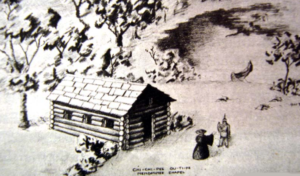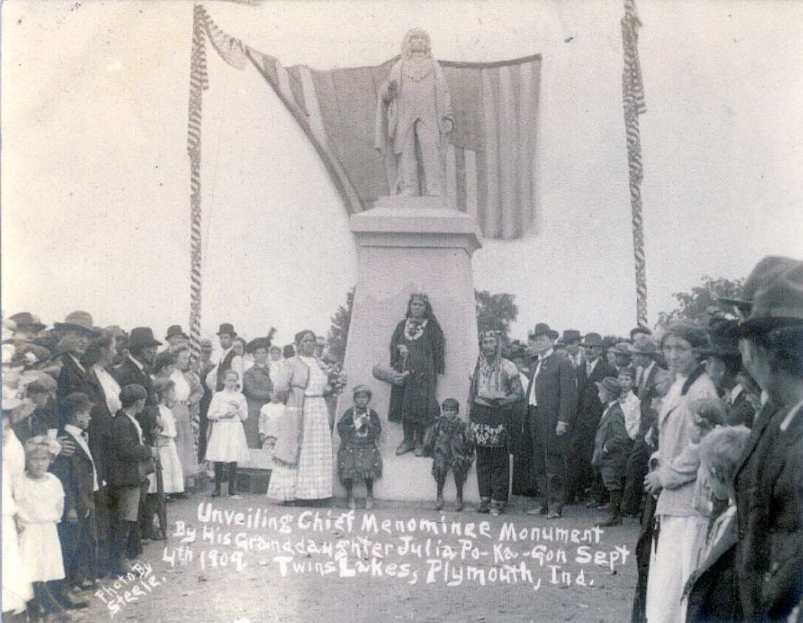Local Heritage
Lakes Area is Home to a Wealth of Native American History
Writer / Jeff Kenney
Photography Provided
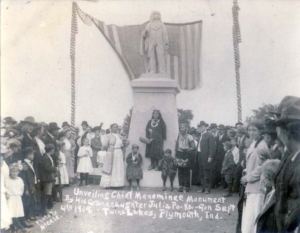 November is National Native American Heritage Month, besides being a period when many Americans contemplate the relationship between early settlers and Native Americans, particularly in relation to the Thanksgiving holiday. The Lakes area is home to a story – in many ways a tragic one – of national significance to the story of North America’s indigenous peoples.
November is National Native American Heritage Month, besides being a period when many Americans contemplate the relationship between early settlers and Native Americans, particularly in relation to the Thanksgiving holiday. The Lakes area is home to a story – in many ways a tragic one – of national significance to the story of North America’s indigenous peoples.
The Potawatomi were not the first Native Americans in the area (in fact, they were fairly recent successors to the Miami here), but they were the last, forced away as they were on the infamous Trail of Death in September of 1838.
Prior to that, among the Potawatomi bands in the area were villages on the shores of a handful of Lakes-area bodies of water. Lake Maxinkuckee (whose name itself is Potawatomi in origin) was home to the village of Chief Nas-wau-kee (alternate spellings, including Nees-Wau-Gee, exist, since the Potawatomi language at the time was phonetic and not written), along with his brother Quash-Qua, on the east shore of the lake on today’s 18B Road, as well as that of Chief Aubbeenaubbee, whose lands extended into Fulton County and also bordered the south shore of the lake.
Cook Lake, the westernmost of the Twin Lakes (the other being Myers Lake), south of Plymouth at 12th and Peach roads, was the home of Chief Menominee and his band. Lake Kee-Wau-Nay, today’s Lake Bruce, in Pulaski County, bore the name of the chief who presided over the band on its shores. As might be assumed, the nearby town of Kewanna is named for the chief, a veteran of the legendary 1811 Battle of Tippecanoe.
All figure significantly in the story of the removal of the Potawatomi from the area.
Various treaties with the U.S. government had been signed leading up to the July 1837 council held at Lake Kee-Wau-Nay. There, government representatives heard an impassioned speech given by Maxinkuckee’s Chief Nas-wau-kee, who had been chosen to represent the region’s Potawatomi in hopes of retaining their tribal lands.
Present at the council in 1837 was another figure of note, British artist George Winter, who had journeyed to New York to study art, and had made his way to northern Indiana for the express purpose of documenting, artistically, the culture and lifestyle of the Potawatomi, aware that they were facing their last days in the region. His remarkably detailed artwork and journal entries comprise the book “Indians and a Changing Frontier: The Art of George Winter” (1993, Indiana Historical Society Press), which includes much greater detail on this story as well as his painting of the council itself.
Nas-wau-kee gathered area white settlers in his village the month after the council and, having agreed to leave peaceably with his band, bid a tearful farewell to his land and his neighbors, saying, in part, “The white settlers here have been good and kind to us, and in leaving them it seems like severing the ties of our own kindred and friends. We go away and may never return, but wherever we may be – wherever our lot in life may be cast we shall always remember you with sincere respect and esteem.”
This group of 47 Potawatomi, which also included Chief Kee-Wau-Nay, arrived in Kansas on October 23, 1837.
As part of an area Eagle Scout project, a marker honoring Nas-wau-kee was placed in 2011 in the town park in Culver. The chief’s great-great-grandniece, Michale Edwards, who had traveled from Oklahoma, was on hand for the event.
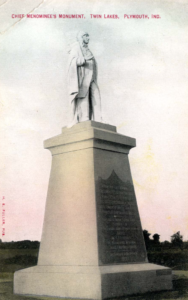
The story of Chief Aubbeenaubbee, as noted in an article in last month’s edition of The Lakes Magazine, was considerably more gruesome and involved the old chief killing his own wife, and the chief’s son Pau-Koo-Shuck assigned the task of killing his own father in retribution. While the historical record is unclear as to whether Pau-Koo-Shuck departed alongside Nas-wau-kee in 1837, or was part of the Trail of Death the following year, he returned to Lake Maxinkuckee rather than making the journey all the way to Kansas. He died soon after, and the story of his ghost haunting the shores of the lake made it into several collections of regional and national folklore and ghost stories.
The story is also commemorated via another Eagle Scout project, a historical marker just outside the Masonic Cemetery in Culver, on the south end of South Street.
The best-known facet of the story of the last days of the Lakes area Potawatomi pertains to Chief Menominee, whose village became home to the first church built in Marshall County – a log cabin Catholic chapel on the north shore of the lake, erected to serve the area Potawatomi. A boulder and historical marker, placed at the site on 12th Road in 1949, commemorates the church “at Chi-chi-pee Ou-ti-pe.”
Assigned to the chapel was French priest Father Benjamin Petit, just 27 years old at the time of the Potawatomi removal. His letters and journal entries, which have been collected in a book published by the Indiana Historical Society and are available at archive.org, recount in detail his love of the Potawatomi and his grief at their mistreatment leading up to the Trail of Death.
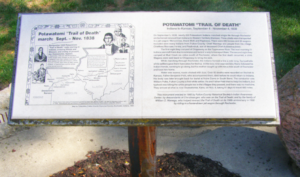
Menominee himself had refused to take part in the 1836 Yellow River Treaty, which removed the land from his ownership, refuting its legality to Indian agent Colonel Abel C. Pepper: “[The U.S. President] does not know that you made my young chiefs drunk and got their consent and pretended to get mine. He would not drive me from my home and the graves of my tribe, and my children, who have gone to the Great Spirit, nor allow you to tell me your braves will take me, tied like a dog, if he knew the truth…I have not sold my lands. I will not sell them. I have not signed any treaty, and will not sign any.”
Nonetheless, General John Tipton would soon thereafter lead a volunteer militia that surrounded the village, deceiving the Potawatomi into gathering in the chapel (Petit was in South Bend at the time) and imprisoning Menominee and other chiefs.
On September 4, 1938, the approximately 660-mile journey of 859 Potawatomi to Kansas began. By its end, 42 had died, 28 of them children. Petit, having obtained permission from his superiors to join the caravan, traveled with them to Kansas, though he would also die from the journey, his remains eventually entombed in honor under the replica log cabin chapel on the campus of the University of Notre Dame.
One early advocate of recognition of the tragedy of the Trail of Death was pioneer descendant and Marshall County historian Daniel McDonald. In his role as a state senator, McDonald introduced legislation to erect a monument to Chief Menominee that was dedicated (originally along with a small replica of the log cabin chapel, which burned some years later) in September of 1909.
The statue, located on Peach Road north of 13th Road, was the first state-sponsored monument to a Native American in the entire U.S.
McDonald also wrote the book “Removal of the Pottawattomie Indians from Northern Indiana” in 1899, documenting the story. His research and interviews with early settlers (published also in his book “A Twentieth Century History of Marshall County, Indiana”) provide some of the most detailed information on the Potawatomi of the Lakes area.
Today, due to the efforts of a number of organizations and individuals including the Fulton County Historical Society (whose annual Trail of Courage event each September commemorates the legacy of the Potawatomi), historical markers have been erected not only in the Lakes area along the route of the Trail of Death, but also at sites all along it up to and including Kansas.
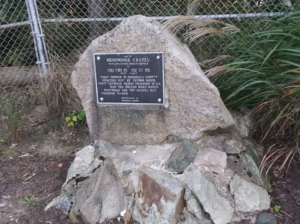
In 2017, St. Joseph Catholic Church in Rochester hosted an event commemorating Indiana Indian Day. At the request of Fulton County historian Shirley Willard, who for some years has led marches retracing the Trail of Death every five years, Indiana Governor Eric Holcomb not only declared the day, but also issued a formal apology to the Potawatomi.
The proclamation certainly applies to the Lakes readership area as well as the state as a whole. Indiana, it says, “recognizes the special and historical significance of the many Indian tribes that have their legacy cemented in Indiana history as well as the sacrifices that these groups have made throughout the history of Indiana.”
